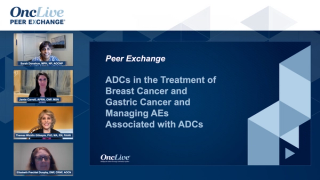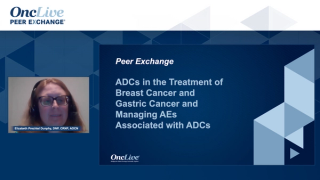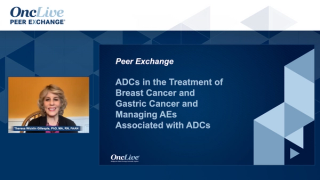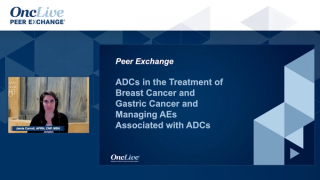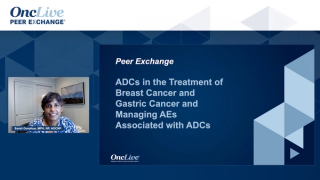
Breast Cancer
Latest News

Latest Videos

More News

Breast-conserving therapy following preoperative systemic therapy resulted in superior overall survival compared with mastectomy in patients with HER2-positive breast cancer.

The FDA granted accelerated approval to fam-trastuzumab deruxtecan-nxki (Enhertu) for patients with unresectable or metastatic HER2-positive solid tumors who have received prior systemic treatment.

The biologics license application for datopotamab deruxtecan has been accepted by the FDA for pretreated HR-positive, HER2-negative metastatic breast cancer.

Patients with early-stage breast cancer treated with ribociclib plus a nonsteroidal aromatase inhibitor provided a greater invasive disease-free survival benefit compared with nonsteroidal aromatase inhibitor therapy alone.
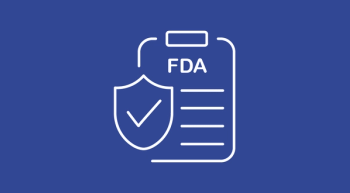
The safety label for fluorouracil products will now include information about the agent’s use in patients with dihydropyrimidine dehydrogenase deficiency.

With the progress made with ADCs, there is interest in moving these agents up in the treatment paradigm for HR-positive/HER2-negative breast cancer.

In a 16-to-2 vote, the FDA's Medical Imaging Drugs Advisory Committee voted in support of the benefit-risk profile of Lumisight to detect cancerous tissue during breast conservation surgery.

Cancer teams, including oncology nurses, can make conscious choices to potentially alleviate the disparities that persist in hypofractionation, toxicity, and cardiac doses in radiotherapy for Black and Asian patients with breast cancer.

Treatment-emergent symptoms were easily resolved after treatment with olaparib for BRCA1/2 high-risk HER2-negative breast cancer, as shown in a patient reported outcome analysis of the phase 3 OlympiA trial.

A treatment for NTRK-positive locally advanced or metastatic solid tumors, repotrectinib, is currently under priority review by the FDA and may address a high unmet medical need.

Although breast cancer has historically been associated with female patients, the rates of men with breast cancer have been increasing over the past decade.

Fast track designation has been granted by the FDA to vepdegestrant for the treatment of select patients with ER-positive/HER2-negative locally advanced or metastatic breast cancer.

With a new approval for elacestrant, patients with ER+/HER2–, ESR1-mutated metastatic breast cancer have an oral alternative to fulvestrant.

A recent study found that a 2.5-mg dose of olanzapine was noninferior to the 10.0-mg dose to control nausea/vomiting in patients with solid tumors treated with chemotherapy and was able to reduce daytime drowsiness from the drug.

Disitamab vedotin either alone or with TKIs, ICIs, or other antiangiogenic agents were consistently effective in patients with HER2-positive or -low breast cancers.

Treatment with pegylated liposomal doxorubicin and cyclophosphamide in the neoadjuvant setting, followed by a taxane, in addition to trastuzumab and pertuzumab, resulted in antitumor activity in patients with HER2-positive breast cancer.

A new drug application for SH-105 has been accepted by the FDA to potentially treat patients with breast and ovarian cancer.

The Food and Drug Administration approved an on-body delivery system for pegfilgrastim-cbqv, a biosimilar of pegfilgrastim.

Oncology nurses may play a role in the utilization of artificial intelligence in the clinical setting.

When compared with palbociclib and fulvestrant, adding inavolisib to the regimen improved progression-free survival in some patients with PIK3CA-mutated, hormone receptor–positive, HER2-negative, locally advanced or metastatic breast cancer.

The survival benefit derived from T-DM1—particularly invasive disease-free survival and overall survival—persisted throughout 8 years of follow-up in HER2-positive early breast cancer with residual invasive disease.

Overall, the transition from breast to genitourinary cancer has added depth and dimension to my knowledge of cancer care.

Findings presented at the 2023 San Antonio Breast Cancer Symposium described some possible avenues for artificial intelligence to be useful in breast cancer care.

The 5-year event-free survival rate was 81.3% with neoadjuvant pembrolizumab/chemotherapy followed by adjuvant pembrolizumab, compared with 72.3% in those who received placebo/chemotherapy plus placebo.

Data from the phase 3 EMERALD trial showed that elacestrant’s benefit was consistent across various subgroups.





